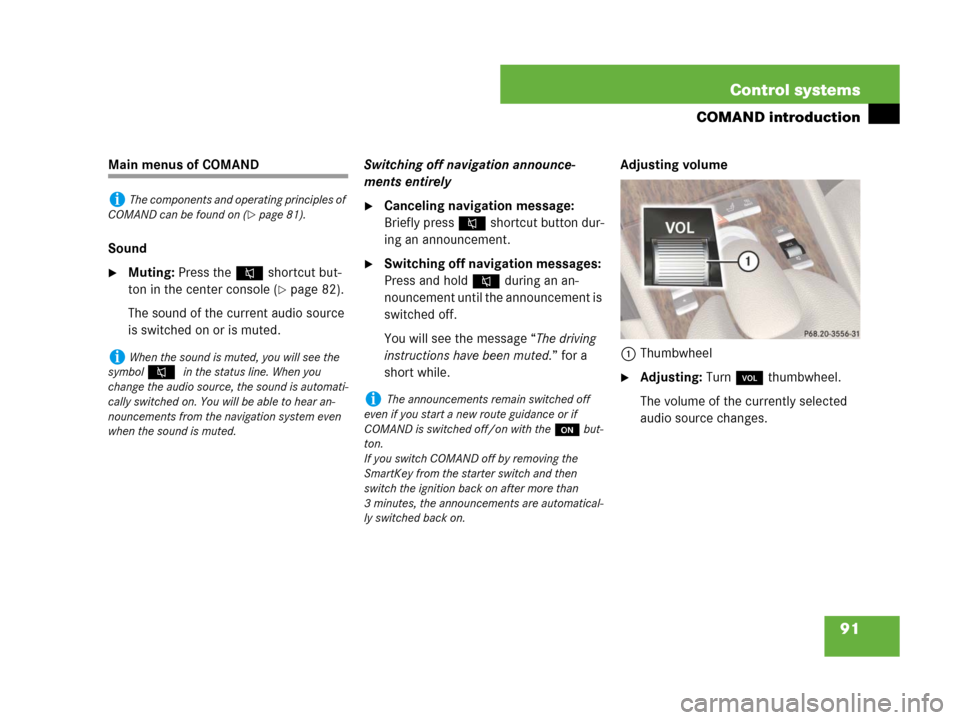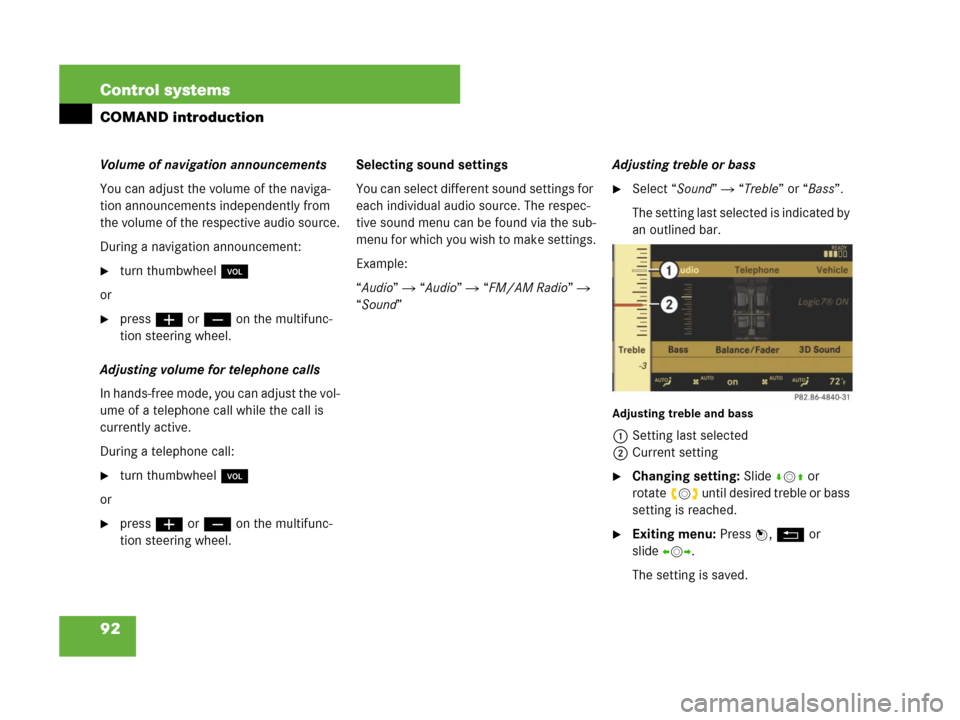Page 69 of 723

68 Safety and Security
Driving safety systems
When you step quickly on the brake pedal
in an emergency braking situation,
BAS Plus automatically regulates the
brake power boost to a level that is suit-
able for the traffic situation.
If BAS Plus requires a particularly high
brake power boost, PRE-SAFE
® is activat-
ed at the same time.
�Keep constant pressure on the brake
pedal until the emergency braking situ-
ation is over.
During this process, ABS prevents the
wheels from locking up.The brakes will resume normal operation
after
�the brake pedal is released
�no obstacles are detected in your path
�the system no longer senses a risk of a
collision
BAS Plus is deactivated.
BAS Plus can react to stationary obstacles
such as standing or parked vehicles at
road speeds of up to approximately
40 mph (70 km/h).
BAS Plus can only assist you when the
radar sensors are switched on and func-
tional. You can check whether the sensors
are active by switching on DISTRONIC
Plus* (
�page 411) or using the “Radar
sensor” menu (
�page 272) in the instru-
ment cluster control system.
Warning!G
BAS Plus will only respond with brake assis-
tance if it has clearly detected an object. De-
tection can be impeded by
�dirty or covered sensors
�snowfall or heavy rain
�disturbance from other radar sources
�strong radar reflection such as in park-
ing garages
BAS Plus uses radar signals that are not re-
flected well by narrow objects and absorp-
tive materials. For this reason BAS Plus will
not react to
�persons and animals
�approaching traffic or cross-traffic
BAS Plus may not detect narrow vehicles
driving in front of you, such as motorcycles
and vehicles driving offset from your vehicle
center.
Page 70 of 723

69 Safety and Security
Driving safety systems
After a hard collision or damage to the
front of the vehicle from an accident, have
the adjustment and operation of the radar
sensors checked by an authorized
Mercedes-Benz Center.
If BAS Plus is not available due to a radar
sensor malfunction, the braking system
will continue to function normally with full
brake boost and full standard BAS
function.EBP
The Electronic Brake Proportioning (EBP)
enhances braking effectiveness by allow-
ing the rear brakes to supply a greater pro-
portion of the braking effort in straight line
braking without a loss of vehicle stability.ESP®
The Electronic Stability Program (ESP®) is
operational as soon as the engine is run-
ning and monitors the vehicle’s traction
(force of adhesive friction between the
tires and the road surface) and handling.
The ESP
® recognizes when a wheel is spin-
ning or if the vehicle starts to skid. By ap-
plying brakes to the appropriate wheel and
by limiting the engine output, the ESP
®
works to stabilize the vehicle. The ESP® is
especially useful while driving off and on
wet or slippery road surfaces. The ESP
®
also stabilizes the vehicle during braking
and steering maneuvers.
The ESP
® warning lamp v in the instru-
ment cluster flashes when the ESP® is en-
gaged.
The ESP
® warning lamp v in the instru-
ment cluster comes on when you switch on
the ignition (
�page 336). It goes out when
the engine is running.
Warning!G
When the EBP is malfunctioning, the ABS,
BAS, BAS Plus* and ESP® are also switched
off.
If the EBP is malfunctioning, the brake sys-
tem will still function with full brake boost.
However, the rear wheels could lock up dur-
ing emergency braking situations, for exam-
ple. You could lose control of the vehicle and
cause an accident. Adapt your driving style
to the changed driving characteristics.
Page 71 of 723

70 Safety and Security
Driving safety systems
For more information, see “Practical hints”
section (
�page 572) and (�page 580).
Warning!G
Never switch off the ESP® when you see the
ESP® warning lamp v flashing in the in-
strument cluster. In this case proceed as fol-
lows:
�While driving off, apply as little throttle
as possible.
�While driving, ease up on the accelera-
tor.
�Adapt your speed and driving style to
the prevailing road conditions.
Failure to observe these guidelines could
cause the vehicle to skid.
The ESP
® cannot prevent accidents result-
ing from excessive speed.
Warning!G
The ESP® cannot prevent the natural laws of
physics from acting on the vehicle, nor can
it increase the traction afforded. The ESP
®
cannot prevent accidents, including those
resulting from excessive speed in turns, or
hydroplaning. Only a safe, attentive, and
skillful driver can prevent accidents. The ca-
pabilities of an ESP
® equipped vehicle must
never be exploited in a reckless or danger-
ous manner which could jeopardize the us-
er’s safety or the safety of others.
iDISTRONIC Plus* and cruise control are
switched off when the ESP® engages.
iThe ESP® will only function properly if you
use wheels of the recommended tire size
(
�page 678).
!Because the ESP® operates automatically,
the engine and ignition must be shut off
(SmartKey in starter switch position0 or1 or
KEYLESS-GO start/stop button* in position0
or1) when
�the electronic parking brake is being tested
on a brake test dynamometer
�the vehicle is being towed with the
front/rear axle raised
Active braking action through the ESP
® may oth-
erwise seriously damage the brake system.
Page 72 of 723

71 Safety and Security
Driving safety systems
Electronic traction system
The electronic traction system is a compo-
nent of ESP
®.
The electronic traction system improves
the vehicle’s ability to utilize available trac-
tion, especially under slippery road condi-
tions by applying the brakes to a spinning
wheel.
When you switch off the ESP
®, the elec-
tronic traction system is still enabled.Switching off the ESP
®
To improve the vehicle’s traction, turn off
the ESP® in driving situations where it
would be advantageous to have the drive
wheels spin and thus cut into surfaces for
better grip such as:
�when driving with snow chains
�in deep snow
�in sand or gravelWhen you switch off the ESP
®
�the ESP® does not stabilize the vehicle
�the engine output is not limited, which
allows the drive wheels to spin and
thus cut into surfaces for better grip
�the electronic traction system will still
apply the brakes to a spinning wheel
�the ESP® continues to operate when
you are braking
�you cannot activate the cruise control
or the DISTRONIC Plus*
Warning!G
If you are driving too fast, the electronic
traction system cannot reduce the risk of an
accident.
The electronic traction system cannot pre-
vent the natural laws of physics from acting
on the vehicle.
Warning!G
The ESP® should not be switched off during
normal driving other than in the circum-
stances described below. Disabling of the
system will reduce vehicle stability in stan-
dard driving maneuvers.
Warning!G
Switch on the ESP® immediately if the afore-
mentioned circumstances do not apply any-
more. Otherwise the ESP
® will not stabilize
the vehicle when it is starting to skid or a
wheel is spinning.
Page 73 of 723
72 Safety and Security
Driving safety systems
1ESP® off/on
�Press ESP® switch1 until the ESP®
warning lampv in the instrument
cluster comes on.
The ESP
® is switched off.Switching on the ESP
®
�Press ESP® switch1.
The ESP
® warning lampv in the in-
strument cluster goes out.
You are now again in normal driving
mode with the ESP
® switched on.
iWhen the ESP® is switched off and one or
more drive wheels are spinning, the ESP® warn-
ing lampv in the instrument cluster flashes.
However, the ESP
® will then not stabilize the
vehicle.
Warning!G
When the ESP® warning lampv is illumi-
nated continuously, the ESP® is switched
off.
Adapt your speed and driving to the prevail-
ing road conditions and to the non-operating
status of the ESP
®.
!Avoid spinning of a drive wheel for an
extended period with the ESP® switched off. This
may cause serious damage to the drivetrain
which is not covered by the Mercedes-Benz
Limited Warranty.
Page 84 of 723
83 Control systems
COMAND introduction
Instrument cluster multifunction
display
This section describes features and con-
trols via the COMAND controller, display
and shortcut buttons only.
Please refer to the “Instrument cluster
control system” section of this manual
(
�page 256) for function descriptions and
operation of the instrument cluster multi-
function display and multifunction steering
wheel buttons as they relate to COMAND
features described in this section.Adjusting COMAND display illumina-
tion
1Knob
�Brightening illumination: Turn
knob1 clockwise.
�Dimming illumination: Turn knob1
counterclockwise.Swiveling COMAND display
1Button for swiveling display to the left
2Button for swiveling display to the right
You can swivel the COMAND display to the
left or right. The buttons are on the
right-hand side of the instrument cluster.
iThe layout of the menus may vary depending
on your vehicle’s equipment. This manual shows
the menus for a fully equipped vehicle.
Page 92 of 723

91 Control systems
COMAND introduction
Main menus of COMAND
Sound
�Muting: Press the F shortcut but-
ton in the center console (
�page 82).
The sound of the current audio source
is switched on or is muted.Switching off navigation announce-
ments entirely
�Canceling navigation message:
Briefly press F shortcut button dur-
ing an announcement.
�Switching off navigation messages:
Press and hold F during an an-
nouncement until the announcement is
switched off.
You will see the message “The driving
instructions have been muted.” for a
short while.Adjusting volume
1Thumbwheel
�Adjusting: Turn, thumbwheel.
The volume of the currently selected
audio source changes.
iThe components and operating principles of
COMAND can be found on (
�page 81).
iWhen the sound is muted, you will see the
symbol
F in the status line. When you
change the audio source, the sound is automati-
cally switched on. You will be able to hear an-
nouncements from the navigation system even
when the sound is muted.
iThe announcements remain switched off
even if you start a new route guidance or if
COMAND is switched off/on with theo but-
ton.
If you switch COMAND off by removing the
SmartKey from the starter switch and then
switch the ignition back on after more than
3 minutes, the announcements are automatical-
ly switched back on.
Page 93 of 723

92 Control systems
COMAND introduction
Volume of navigation announcements
You can adjust the volume of the naviga-
tion announcements independently from
the volume of the respective audio source.
During a navigation announcement:
�turn thumbwheel,
or
�pressæ or ç on the multifunc-
tion steering wheel.
Adjusting volume for telephone calls
In hands-free mode, you can adjust the vol-
ume of a telephone call while the call is
currently active.
During a telephone call:
�turn thumbwheel,
or
�pressæ or ç on the multifunc-
tion steering wheel.Selecting sound settings
You can select different sound settings for
each individual audio source. The respec-
tive sound menu can be found via the sub-
menu for which you wish to make settings.
Example:
“Audio” � “Audio” � “FM/AM Radio” �
“Sound” Adjusting treble or bass
�Select “Sound” � “Treble” or “Bass”.
The setting last selected is indicated by
an outlined bar.
Adjusting treble and bass
1Setting last selected
2Current setting
�Changing setting: Slide rmq or
rotateymz until desired treble or bass
setting is reached.
�Exiting menu: Press n, L or
slideomp.
The setting is saved.